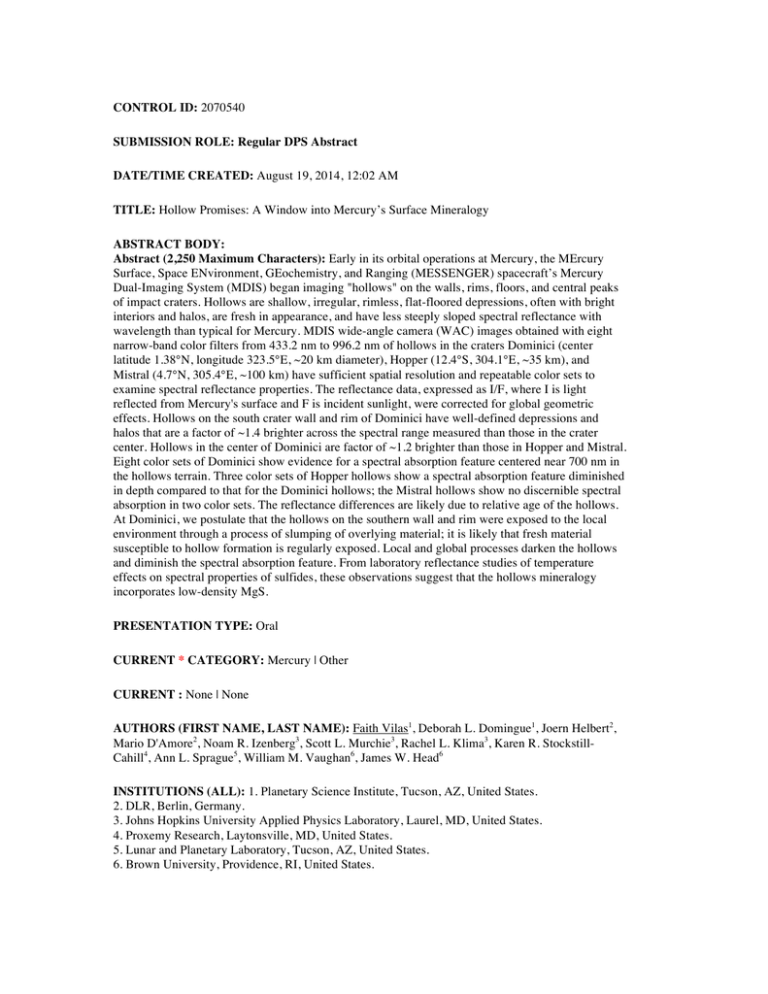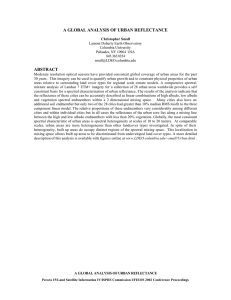CONTROL ID: SUBMISSION ROLE: Regular DPS Abstract DATE/TIME CREATED: TITLE:
advertisement

CONTROL ID: 2070540 SUBMISSION ROLE: Regular DPS Abstract DATE/TIME CREATED: August 19, 2014, 12:02 AM TITLE: Hollow Promises: A Window into Mercury’s Surface Mineralogy ABSTRACT BODY: Abstract (2,250 Maximum Characters): Early in its orbital operations at Mercury, the MErcury Surface, Space ENvironment, GEochemistry, and Ranging (MESSENGER) spacecraft’s Mercury Dual-Imaging System (MDIS) began imaging "hollows" on the walls, rims, floors, and central peaks of impact craters. Hollows are shallow, irregular, rimless, flat-floored depressions, often with bright interiors and halos, are fresh in appearance, and have less steeply sloped spectral reflectance with wavelength than typical for Mercury. MDIS wide-angle camera (WAC) images obtained with eight narrow-band color filters from 433.2 nm to 996.2 nm of hollows in the craters Dominici (center latitude 1.38°N, longitude 323.5°E, ~20 km diameter), Hopper (12.4°S, 304.1°E, ~35 km), and Mistral (4.7°N, 305.4°E, ~100 km) have sufficient spatial resolution and repeatable color sets to examine spectral reflectance properties. The reflectance data, expressed as I/F, where I is light reflected from Mercury's surface and F is incident sunlight, were corrected for global geometric effects. Hollows on the south crater wall and rim of Dominici have well-defined depressions and halos that are a factor of ~1.4 brighter across the spectral range measured than those in the crater center. Hollows in the center of Dominici are factor of ~1.2 brighter than those in Hopper and Mistral. Eight color sets of Dominici show evidence for a spectral absorption feature centered near 700 nm in the hollows terrain. Three color sets of Hopper hollows show a spectral absorption feature diminished in depth compared to that for the Dominici hollows; the Mistral hollows show no discernible spectral absorption in two color sets. The reflectance differences are likely due to relative age of the hollows. At Dominici, we postulate that the hollows on the southern wall and rim were exposed to the local environment through a process of slumping of overlying material; it is likely that fresh material susceptible to hollow formation is regularly exposed. Local and global processes darken the hollows and diminish the spectral absorption feature. From laboratory reflectance studies of temperature effects on spectral properties of sulfides, these observations suggest that the hollows mineralogy incorporates low-density MgS. PRESENTATION TYPE: Oral CURRENT * CATEGORY: Mercury | Other CURRENT : None | None AUTHORS (FIRST NAME, LAST NAME): Faith Vilas1, Deborah L. Domingue1, Joern Helbert2, Mario D'Amore2, Noam R. Izenberg3, Scott L. Murchie3, Rachel L. Klima3, Karen R. StockstillCahill4, Ann L. Sprague5, William M. Vaughan6, James W. Head6 INSTITUTIONS (ALL): 1. Planetary Science Institute, Tucson, AZ, United States. 2. DLR, Berlin, Germany. 3. Johns Hopkins University Applied Physics Laboratory, Laurel, MD, United States. 4. Proxemy Research, Laytonsville, MD, United States. 5. Lunar and Planetary Laboratory, Tucson, AZ, United States. 6. Brown University, Providence, RI, United States.





